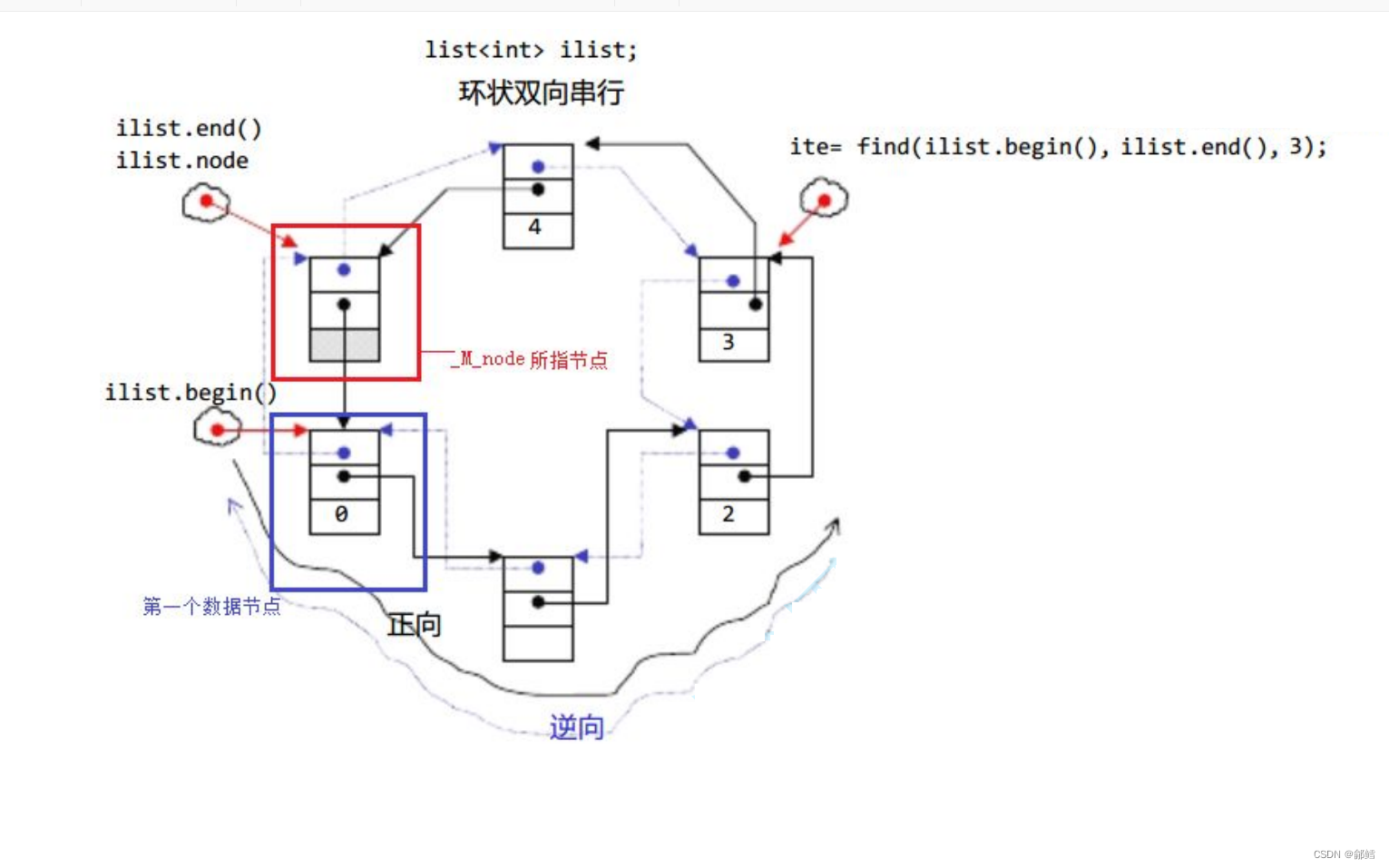文章目录

将文档翻译提炼得到以下结论
-
list是可以在常数范围内在任意位置进行插入和删除的序列式容器,并且该容器可以前后双向迭代。
-
list的底层是双向链表结构,双向链表中每个元素存储在互不相关的独立节点中,在节点中通过指针指向其前一个元素和后一个元素。
-
list与forward_list非常相似:最主要的不同在于forward_list是单链表,只能朝前迭代,已让其更简单高效。
-
与其他的序列式容器相比(array,vector,deque),list通常在任意位置进行插入、移除元素的执行效率更好。
-
与其他序列式容器相比,list和forward_list最大的缺陷是不支持任意位置的随机访问,比如:要访问list的第6个元素,必须从已知的位置(比如头部或者尾部)迭代到该位置,在这段位置上迭代需要线性的时间开销;list还需要一些额外的空间,以保存每个节点的相关联信息(对于存储类型较小元素的大list来说这可能是一个重要的因素)
push_front &&pop_front
#include <iostream>
#include <list>
using namespace std;
int main()
{
list<int> lt;
lt.push_front(0);
lt.push_front(1);
lt.push_front(2);
for (auto e : lt)
{
cout << e << " ";
}
cout << endl; //2 1 0
lt.pop_front();
for (auto e : lt)
{
cout << e << " ";
}
cout << endl; //1 0
return 0;
}
push_back&&pop_back
#include <iostream>
#include <list>
using namespace std;
int main()
{
list<int> lt;
lt.push_back(0);
lt.push_back(1);
lt.push_back(2);
lt.push_back(3);
for (auto e : lt)
{
cout << e << " ";
}
cout << endl; //0 1 2 3
lt.pop_back();
lt.pop_back();
for (auto e : lt)
{
cout << e << " ";
}
cout << endl;//0 1
return 0;
}
insert
1、在指定迭代器位置插入一个数。
2、在指定迭代器位置插入n个值为val的数。
3、在指定迭代器位置插入一段迭代器区间(左闭右开)。
insert以后迭代器不会失效
#include <iostream>
#include <algorithm>
#include <vector>
#include <list>
using namespace std;
int main()
{
list<int> lt;
lt.push_back(1);
lt.push_back(2);
lt.push_back(3);
list<int>::iterator pos = find(lt.begin(), lt.end(), 2);
//auto pos =find (lt.begin(),lt.end() ,2);
lt.insert(pos, 9); //在2的位置插入9
for (auto e : lt)
{
cout << e << " ";
}
cout << endl; //1 9 2 3
pos = find(lt.begin(), lt.end(), 3);
lt.insert(pos, 2, 8); //在3的位置插入2个8
for (auto e : lt)
{
cout << e << " ";
}
cout << endl; //1 9 2 8 8 3
vector<int> v(2, 7);
pos = find(lt.begin(), lt.end(), 1);
lt.insert(pos, v.begin(), v.end()); //在1的位置插入2个7
for (auto e : lt)
{
cout << e << " ";
}
cout << endl; //7 7 1 9 2 8 8 3
return 0;
}
erase
1、删除指定迭代器位置的元素。
2、删除指定迭代器区间(左闭右开)的所有元素。
erase 以后迭代器可能会失效
#include <iostream>
#include <algorithm>
#include <vector>
#include <list>
using namespace std;
int main()
{
list<int> lt;
lt.push_back(1);
lt.push_back(2);
lt.push_back(3);
lt.push_back(4);
lt.push_back(5);
list<int>::iterator pos = find(lt.begin(), lt.end(), 2);
lt.erase(pos); //删除2
for (auto e : lt)
{
cout << e << " ";
}
cout << endl; //1 3 4 5
pos = find(lt.begin(), lt.end(), 4);
lt.erase(pos, lt.end()); //删除4及其之后的元素
for (auto e : lt)
{
cout << e << " ";
}
cout << endl; //1 3
return 0;
}
迭代器
begin&& end

begin函数得到容器中第一个元素的正向迭代器,通过end函数可以得到容器中最后一个元素的后一个位置的正向迭代器。
#include <iostream>
#include <list>
using namespace std;
int main()
{
list<int> lt(10, 2);
//正向迭代器遍历容器
list<int>::iterator it = lt.begin();
while (it != lt.end())
{
cout << *it << " ";
it++;
}
cout << endl;
return 0;
}
rbegin和rend
#include <iostream>
#include <list>
using namespace std;
int main()
{
list<int> lt(10, 2);
//反向迭代器遍历容器
list<int>::reverse_iterator rit = lt.rbegin();
while (rit != lt.rend())
{
cout << *rit << " ";
rit++;
}
cout << endl;
return 0;
}
front&&back
#include <iostream>
#include <list>
using namespace std;
int main()
{
list<int> lt;
lt.push_back(0);
lt.push_back(1);
lt.push_back(2);
lt.push_back(3);
lt.push_back(4);
cout << lt.front() << endl; //0
cout << lt.back() << endl; //4
return 0;
}
size
#include <iostream>
#include <list>
using namespace std;
int main()
{
list<int> lt;
lt.push_back(1);
lt.push_back(2);
lt.push_back(3);
lt.push_back(4);
cout << lt.size() << endl; //4
return 0;
}
resize
当所给值 >当前的size时,将size扩大到该值,扩大的数据为第二个所给值,若未给出,则默认为容器所存储类型的默认构造函数所构造出来的值。
当所给值<当前的size时,将size缩小到该值
#include <iostream>
#include <list>
using namespace std;
int main()
{
list<int> lt(5, 3);
for (auto e : lt)
{
cout << e << " ";
}
cout << endl; //3 3 3 3 3
lt.resize(7, 6); //将size扩大为7,扩大的值为6
for (auto e : lt)
{
cout << e << " ";
}
cout << endl; //3 3 3 3 3 6 6
lt.resize(2); //将size缩小为2
for (auto e : lt)
{
cout << e << " ";
}
cout << endl; //3 3
return 0;
}
empty
#include <iostream>
#include <list>
using namespace std;
int main()
{
list<int> lt;
cout << lt.empty() << endl; //1
return 0;
}
clear
#include <iostream>
#include <list>
using namespace std;
int main()
{
list<int> lt(5, 2);
for (auto e : lt)
{
cout << e << " ";
}
cout << endl; //2 2 2 2 2
cout << lt.size() << endl; //5
lt.clear(); //清空容器
for (auto e : lt)
{
cout << e << " ";
}
cout << endl; //(无数据)
cout << lt.size() << endl; //0
return 0;
}
sort
默认排升序
#include <iostream>
#include <list>
using namespace std;
int main()
{
list<int> lt;
lt.push_back(4);
lt.push_back(7);
lt.push_back(5);
lt.push_back(9);
lt.push_back(6);
lt.push_back(0);
lt.push_back(3);
for (auto e : lt)
{
cout << e << " ";
}
cout << endl; //4 7 5 9 6 0 3
lt.sort(); //默认将容器内数据排为升序
for (auto e : lt)
{
cout << e << " ";
}
cout << endl; //0 3 4 5 6 7 9
return 0;
}
splice
1、将整个容器拼接到另一个容器的指定迭代器位置。
2、将容器当中的某一个数据拼接到另一个容器的指定迭代器位置。
3、将容器指定迭代器区间的数据拼接到另一个容器的指定迭代器位置
#include <iostream>
#include <list>
using namespace std;
int main()
{
list<int> lt1(4, 2);
list<int> lt2(4, 6);
lt1.splice(lt1.begin(), lt2); //将容器lt2拼接到容器lt1的开头
for (auto e : lt1)
{
cout << e << " ";
}
cout << endl; //6 6 6 6 2 2 2 2
list<int> lt3(4, 2);
list<int> lt4(4, 6);
lt3.splice(lt3.begin(), lt4, lt4.begin()); //将容器lt4的第一个数据拼接到容器lt3的开头
for (auto e : lt3)
{
cout << e << " ";
}
cout << endl; //6 2 2 2 2
list<int> lt5(4, 2);
list<int> lt6(4, 6);
lt5.splice(lt5.begin(), lt6, lt6.begin(), lt6.end()); //将容器lt6的指定迭代器区间内的数据拼接到容器lt5的开头
for (auto e : lt5)
{
cout << e << " ";
}
cout << endl; //6 6 6 6 2 2 2 2
return 0;
}
unique
unique函数用于删除容器当中连续的重复元素。
#include <iostream>
#include <list>
using namespace std;
int main()
{
list<int> lt;
lt.push_back(1);
lt.push_back(4);
lt.push_back(3);
lt.push_back(3);
lt.push_back(2);
lt.push_back(2);
lt.push_back(3);
for (auto e : lt)
{
cout << e << " ";
}
cout << endl; //1 4 3 3 2 2 3
lt.sort(); //将容器当中的元素排为升序
lt.unique(); //删除容器当中连续的重复元素
for (auto e : lt)
{
cout << e << " ";
}
cout << endl; //1 2 3 4
return 0;
}
merge
merge函数用于将一个有序list容器合并到另一个有序list容器当中,使得合并后的list容器仍然有序。
#include <iostream>
#include <list>
using namespace std;
int main()
{
list<int> lt1;
lt1.push_back(3);
lt1.push_back(8);
lt1.push_back(1);
list<int> lt2;
lt2.push_back(6);
lt2.push_back(2);
lt2.push_back(9);
lt2.push_back(5);
lt1.sort(); //将容器lt1排为升序
lt2.sort(); //将容器lt2排为升序
//merge前提是lt1和lt2都有序
lt1.merge(lt2); //将lt2合并到lt1当中
for (auto e : lt1)
{
cout << e << " ";
}
cout << endl; //1 2 3 5 6 8 9
return 0;
}
reverse
reverse函数用于将容器当中元素的位置进行逆置。
#include <iostream>
#include <list>
using namespace std;
int main()
{
list<int> lt;
lt.push_back(1);
lt.push_back(2);
lt.push_back(3);
lt.push_back(4);
lt.push_back(5);
lt.reverse(); //将容器当中元素的位置进行逆置
for (auto e : lt)
{
cout << e << " ";
}
cout << endl; //5 4 3 2 1
return 0;
}
如果你觉得这篇文章对你有帮助,不妨动动手指给点赞收藏加转发,给鄃鳕一个大大的关注,你们的每一次支持都将转化为我前进的动力!!!
